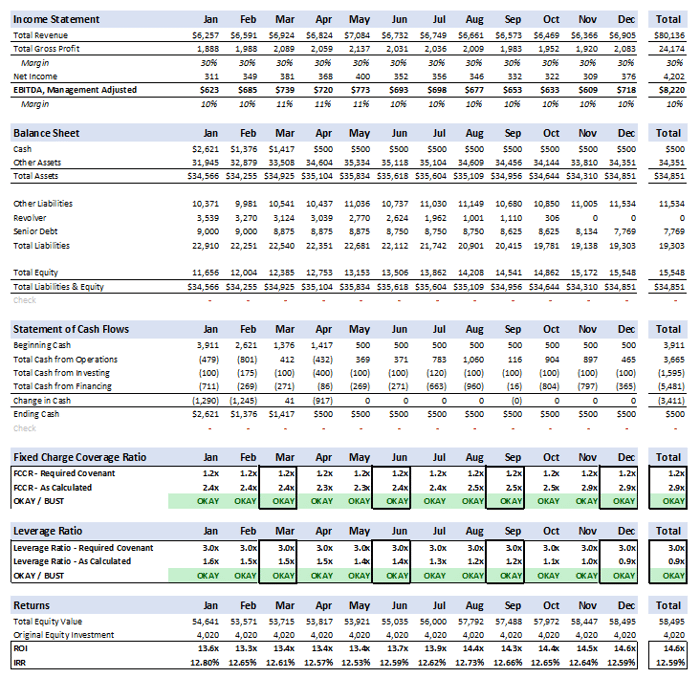Three Statement Modeling
I know that post title seems like clickbaity nonsense but it's not.
The single most valuable skill I have learned in my entire career is Three Statement Modeling.
Nothing else even comes close.
What Everyone Gets Wrong
People always ask me, "hey Chris do you have [this kind of model]?" thinking there is some kind of custom build needed on a case-by-case basis.
The reality is all models roll up to the same place: the Three Statements.
Sure, the components of the model might need to be different, but what you're modeling here are parts of the Income Statement and parts of the Balance Sheet, both of which make up 2 of the 3 Statements.
So when I say I can build:
- SaaS Models
- FP&A Models
- LBO Models
- M&A Models
They're actually all the same thing: a Three Statement Model.
Accounting by Doing
One of the things I love about Three Statement Modeling is it teaches you Accounting through Excel.
Does that mean I know every FASB? Not at all. In fact, I'm not even a CPA.
But, in order to get the pieces of the model to work together, it forces you to learn the underlying accounting to correctly integrate the financial statements.
The most prevalent Accounting Principle being the Matching Principle, which states the Revenue earned must match the Expenses incurred, and this is often why "SaaS models" are a common request.
In SaaS, there's nothing different about the Three Statements, it's just the underlying components, which is to say you typically "build your Revenue" using the Unearned Revenue account on the Balance Sheet so the Revenue on the Income Statement matches the length of the contract (because software contracts are often 12 months long, so you need to "spread the Revenue" over 12 months, not one).
For an "inventory-based" company, you don't typically need to use the Unearned Revenue account, because the sales are generally one-time in nature and therefore match the current period (and nothing needs to be "Deferred" or "Unearned" for later).
My point is this: you're just making changes to the components of the Balance Sheet, but you're not creating some kind of "special model."
Key Things to Remember
Every schedule or sub-schedule in your model should end up in 1 of 2 places:
- Income Statement, or;
- Balance Sheet
And that's it.
Your Statement of Cash Flows should be built automatically (using the "indirect method") and refer to items that already exist in your Income Statement and Balance Sheet, and simply calculate the difference between time periods.
It works like this:
Cash Flow Statement Structure
= Net Income (from Income Statement)
+ Depreciation & Amortization (from Income Statement)
+ the change in Assets, Liabilities, & Equity (from Balance Sheet)
Modeling the Assets
For Assets, it's the previous period minus the current period
(i.e., January's ending AR balance minus February's ending AR balance)
Modeling the Liabilities
For Liabilities, it's the current period minus the previous period
(i.e., February's ending AP balance minus January's ending AP balance)
Modeling the Equity
For Equity, it's the current period minus the previous period (same as Liabilities)
(i.e., February's ending Contributed Capital balance minus January's ending Contributed Capital balance)
The Exception
The only exception to this rule is Fixed Assets, where you will also pull out the Depreciation because it's already captured at the very beginning of the cash flow statement (if it's being shown on a net basis, which is common).
(i.e., January's ending Fixed Asset balance minus February's ending Fixed Asset balance minus February's Depreciation)
Here's an example:
Key Takeaway
The Cash Flow Statement simply uses the information you already have.
Support schedules in your model (i.e., Revenue, Expenses, Headcount, Capex, etc.) should not link to the Statement of Cash Flows.
They should only go to the Income Statement or the Balance Sheet (and the Cash Flow Statement can run automatically).
Btw, we're going to explore all of this in more detail in the upcoming issues.
Action Items
Quiz yourself.
Do you know the Three Statements in your head?
I don't mean list them, I mean can you tell me what happens if:
- We sign a new 12 month contract?
- We hire 3 new people?
- We increase our Advertising spend?
- We purchase a truck?
- We make an Equity Distribution?
If you can immediately communicate the impact of a business decision on the 3 Statements, it will elevate you to the next level in a hurry.
Like I said at the beginning, mastering this skill has had the largest impact on my career, bar none.
Make sure you have it dialed too!
That's it for today. See you next time.
—Chris
Before you go...
Take that "mini quiz" above -- how'd you do? If you felt comfortable, awesome!
If not, you may want to check out my courses and pre-built templates that teach you the Three Statements in detail.
"⭐⭐⭐⭐⭐...so thorough and helpful. Probably the best course on modeling I’ve taken."

